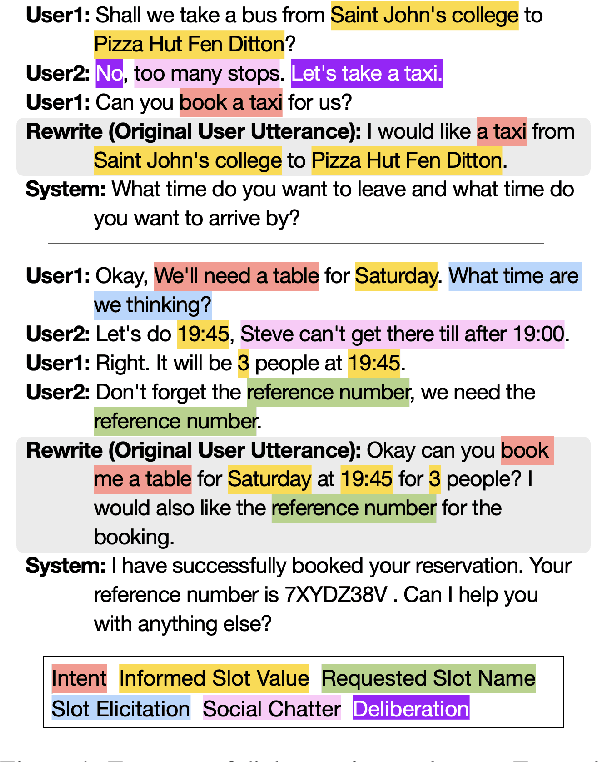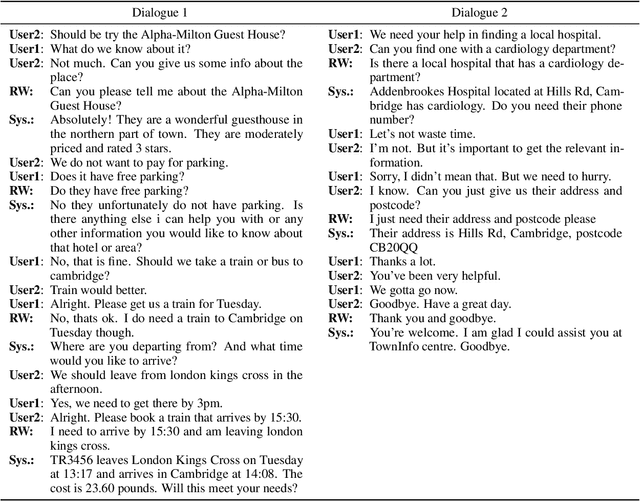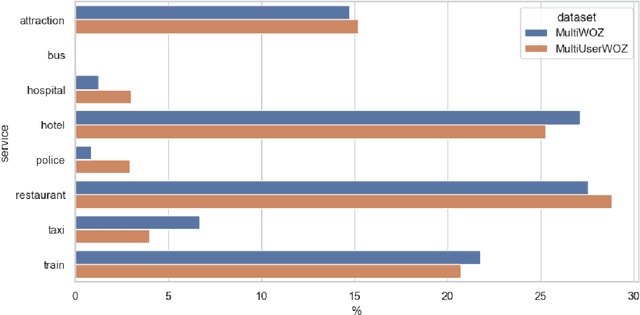Yohan Jo
KMI: A Dataset of Korean Motivational Interviewing Dialogues for Psychotherapy
Feb 08, 2025



Abstract:The increasing demand for mental health services has led to the rise of AI-driven mental health chatbots, though challenges related to privacy, data collection, and expertise persist. Motivational Interviewing (MI) is gaining attention as a theoretical basis for boosting expertise in the development of these chatbots. However, existing datasets are showing limitations for training chatbots, leading to a substantial demand for publicly available resources in the field of MI and psychotherapy. These challenges are even more pronounced in non-English languages, where they receive less attention. In this paper, we propose a novel framework that simulates MI sessions enriched with the expertise of professional therapists. We train an MI forecaster model that mimics the behavioral choices of professional therapists and employ Large Language Models (LLMs) to generate utterances through prompt engineering. Then, we present KMI, the first synthetic dataset theoretically grounded in MI, containing 1,000 high-quality Korean Motivational Interviewing dialogues. Through an extensive expert evaluation of the generated dataset and the dialogue model trained on it, we demonstrate the quality, expertise, and practicality of KMI. We also introduce novel metrics derived from MI theory in order to evaluate dialogues from the perspective of MI.
Model-based Preference Optimization in Abstractive Summarization without Human Feedback
Sep 27, 2024Abstract:In abstractive summarization, the challenge of producing concise and accurate summaries arises from the vast amount of information contained in the source document. Consequently, although Large Language Models (LLMs) can generate fluent text, they often introduce inaccuracies by hallucinating content not found in the original source. While supervised fine-tuning methods that maximize likelihood contribute to this issue, they do not consistently enhance the faithfulness of the summaries. Preference-based optimization methods, such as Direct Preference Optimization (DPO), can further refine the model to align with human preferences. However, these methods still heavily depend on costly human feedback. In this work, we introduce a novel and straightforward approach called Model-based Preference Optimization (MPO) to fine-tune LLMs for improved summarization abilities without any human feedback. By leveraging the model's inherent summarization capabilities, we create a preference dataset that is fully generated by the model using different decoding strategies. Our experiments on standard summarization datasets and various metrics demonstrate that our proposed MPO significantly enhances the quality of generated summaries without relying on human feedback.
DialSim: A Real-Time Simulator for Evaluating Long-Term Dialogue Understanding of Conversational Agents
Jun 19, 2024



Abstract:Recent advancements in Large Language Models (LLMs) have significantly enhanced the capabilities of conversational agents, making them applicable to various fields (e.g., education). Despite their progress, the evaluation of the agents often overlooks the complexities of real-world conversations, such as real-time interactions, multi-party dialogues, and extended contextual dependencies. To bridge this gap, we introduce DialSim, a real-time dialogue simulator. In this simulator, an agent is assigned the role of a character from popular TV shows, requiring it to respond to spontaneous questions using past dialogue information and to distinguish between known and unknown information. Key features of DialSim include evaluating the agent's ability to respond within a reasonable time limit, handling long-term multi-party dialogues, and managing adversarial settings (e.g., swap character names) to challenge the agent's reliance on pre-trained knowledge. We utilized this simulator to evaluate the latest conversational agents and analyze their limitations. Our experiments highlight both the strengths and weaknesses of these agents, providing valuable insights for future improvements in the field of conversational AI. DialSim is available at https://github.com/jiho283/Simulator.
THEANINE: Revisiting Memory Management in Long-term Conversations with Timeline-augmented Response Generation
Jun 16, 2024



Abstract:Large language models (LLMs) are capable of processing lengthy dialogue histories during prolonged interaction with users without additional memory modules; however, their responses tend to overlook or incorrectly recall information from the past. In this paper, we revisit memory-augmented response generation in the era of LLMs. While prior work focuses on getting rid of outdated memories, we argue that such memories can provide contextual cues that help dialogue systems understand the development of past events and, therefore, benefit response generation. We present Theanine, a framework that augments LLMs' response generation with memory timelines -- series of memories that demonstrate the development and causality of relevant past events. Along with Theanine, we introduce TeaFarm, a counterfactual-driven question-answering pipeline addressing the limitation of G-Eval in long-term conversations. Supplementary videos of our methods and the TeaBag dataset for TeaFarm evaluation are in https://theanine-693b0.web.app/.
Mitigating Hallucination in Abstractive Summarization with Domain-Conditional Mutual Information
Apr 15, 2024Abstract:A primary challenge in abstractive summarization is hallucination -- the phenomenon where a model generates plausible text that is absent in the source text. We hypothesize that the domain (or topic) of the source text triggers the model to generate text that is highly probable in the domain, neglecting the details of the source text. To alleviate this model bias, we introduce a decoding strategy based on domain-conditional pointwise mutual information. This strategy adjusts the generation probability of each token by comparing it with the token's marginal probability within the domain of the source text. According to evaluation on the XSUM dataset, our method demonstrates improvement in terms of faithfulness and source relevance. The code is publicly available at \url{https://github.com/qqplot/dcpmi}.
Ever-Evolving Memory by Blending and Refining the Past
Mar 03, 2024Abstract:For a human-like chatbot, constructing a long-term memory is crucial. A naive approach for making a memory could be simply listing the summarized dialogue. However, this can lead to problems when the speaker's status change over time and contradictory information gets accumulated. It is important that the memory stays organized to lower the confusion for the response generator. In this paper, we propose a novel memory scheme for long-term conversation, CREEM. Unlike existing approaches that construct memory based solely on current sessions, our proposed model blending past memories during memory formation. Additionally, we introduce refining process to handle redundant or outdated information. This innovative approach seeks for overall improvement and coherence of chatbot responses by ensuring a more informed and dynamically evolving long-term memory.
Ask Optimal Questions: Aligning Large Language Models with Retriever's Preference in Conversational Search
Feb 19, 2024Abstract:Conversational search, unlike single-turn retrieval tasks, requires understanding the current question within a dialogue context. The common approach of rewrite-then-retrieve aims to decontextualize questions to be self-sufficient for off-the-shelf retrievers, but most existing methods produce sub-optimal query rewrites due to the limited ability to incorporate signals from the retrieval results. To overcome this limitation, we present a novel framework RetPO (Retriever's Preference Optimization), which is designed to optimize a language model (LM) for reformulating search queries in line with the preferences of the target retrieval systems. The process begins by prompting a large LM to produce various potential rewrites and then collects retrieval performance for these rewrites as the retrievers' preferences. Through the process, we construct a large-scale dataset called RF collection, containing Retrievers' Feedback on over 410K query rewrites across 12K conversations. Furthermore, we fine-tune a smaller LM using this dataset to align it with the retrievers' preferences as feedback. The resulting model achieves state-of-the-art performance on two recent conversational search benchmarks, significantly outperforming existing baselines, including GPT-3.5.
Generalizing Visual Question Answering from Synthetic to Human-Written Questions via a Chain of QA with a Large Language Model
Jan 16, 2024Abstract:Visual question answering (VQA) is a task where an image is given, and a series of questions are asked about the image. To build an efficient VQA algorithm, a large amount of QA data is required which is very expensive. Generating synthetic QA pairs based on templates is a practical way to obtain data. However, VQA models trained on those data do not perform well on complex, human-written questions. To address this issue, we propose a new method called {\it chain of QA for human-written questions} (CoQAH). CoQAH utilizes a sequence of QA interactions between a large language model and a VQA model trained on synthetic data to reason and derive logical answers for human-written questions. We tested the effectiveness of CoQAH on two types of human-written VQA datasets for 3D-rendered and chest X-ray images and found that it achieved state-of-the-art accuracy in both types of data. Notably, CoQAH outperformed general vision-language models, VQA models, and medical foundation models with no finetuning.
Multi-User MultiWOZ: Task-Oriented Dialogues among Multiple Users
Oct 31, 2023



Abstract:While most task-oriented dialogues assume conversations between the agent and one user at a time, dialogue systems are increasingly expected to communicate with multiple users simultaneously who make decisions collaboratively. To facilitate development of such systems, we release the Multi-User MultiWOZ dataset: task-oriented dialogues among two users and one agent. To collect this dataset, each user utterance from MultiWOZ 2.2 was replaced with a small chat between two users that is semantically and pragmatically consistent with the original user utterance, thus resulting in the same dialogue state and system response. These dialogues reflect interesting dynamics of collaborative decision-making in task-oriented scenarios, e.g., social chatter and deliberation. Supported by this data, we propose the novel task of multi-user contextual query rewriting: to rewrite a task-oriented chat between two users as a concise task-oriented query that retains only task-relevant information and that is directly consumable by the dialogue system. We demonstrate that in multi-user dialogues, using predicted rewrites substantially improves dialogue state tracking without modifying existing dialogue systems that are trained for single-user dialogues. Further, this method surpasses training a medium-sized model directly on multi-user dialogues and generalizes to unseen domains.
From Values to Opinions: Predicting Human Behaviors and Stances Using Value-Injected Large Language Models
Oct 27, 2023Abstract:Being able to predict people's opinions on issues and behaviors in realistic scenarios can be helpful in various domains, such as politics and marketing. However, conducting large-scale surveys like the European Social Survey to solicit people's opinions on individual issues can incur prohibitive costs. Leveraging prior research showing influence of core human values on individual decisions and actions, we propose to use value-injected large language models (LLM) to predict opinions and behaviors. To this end, we present Value Injection Method (VIM), a collection of two methods -- argument generation and question answering -- designed to inject targeted value distributions into LLMs via fine-tuning. We then conduct a series of experiments on four tasks to test the effectiveness of VIM and the possibility of using value-injected LLMs to predict opinions and behaviors of people. We find that LLMs value-injected with variations of VIM substantially outperform the baselines. Also, the results suggest that opinions and behaviors can be better predicted using value-injected LLMs than the baseline approaches.
 Add to Chrome
Add to Chrome Add to Firefox
Add to Firefox Add to Edge
Add to Edge